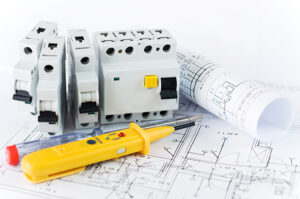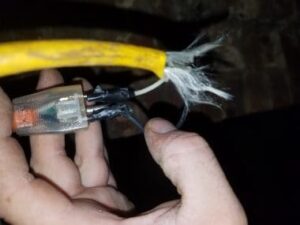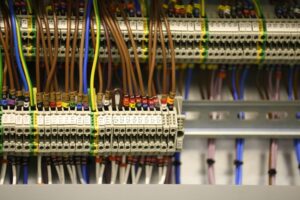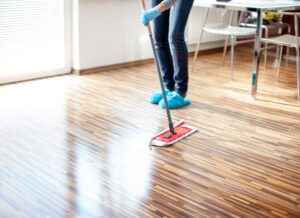Differences Between Engineered and Natural Hardwood Flooring
As anyone will notice, the biggest difference between natural and engineered hardwood is the manufacturing methods between the two. Natural hardwood planks are singular pieces cut from one tree. While engineered planks, or man-made planks, consist of multiple materials with a thin layer of natural wood placed on top to give it the appearance of oak, maple, pine, and more. There are more differences than you may think concerning these two, so to help we have listed them below:
Natural Hardwood: This flooring option has grown significantly in recent years, replacing carpet and laminate floors of the 80s and 90s. While this option may be more expensive, the upfront costs of installation and purchase of materials is cut by the long life and endurance you receive, especially if you have pets and little ones running around the home. They bring heavy traffic and multiple spills, which natural flooring beats every time when compared to engineered hardwood options. It is an option guaranteed to make your investment worthwhile. You also have so many options to choose from since they utilize all wood. You can mix and match planks for a fun and unique look, or you can also choose a stain or varnish to give new life to your timeless flooring.
Engineered Hardwood: The reason engineered hardwood was created was to help give you the appearance of hardwood without the initial high cost and to combat the inefficiencies of its more natural predecessor. Manufactured with multiple layers gives it the endurance reminiscent of natural wood planks and also having a final layer which helps to make it more water resistant. This layer also helps make it easier to clean by allowing mop and water to help remove sticky stains. You will still want to dry the floor quickly as it is not completely waterproof. The middle layers are also created with plywood, fiberwood, and sometimes natural wood to give it strength. It has become very popular recently thanks to being cost-effective and its ability to be installed anywhere in the home. Natural hardwood can’t be installed in basements and you to have a concrete slab as your home’s base layer.
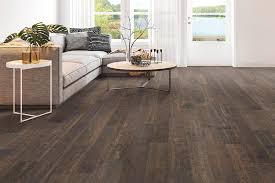
Things to Consider When Choosing Your Hardwood
So you’ve decided to get hardwood floors. Easy enough, right? Pick a wood and be done with it.
Not so fast.
There are a lot of factors that will determine what kind of hardwood floor your home can accommodate, and what will look best with your existing or planned furnishings and decor.
Do you have kids? What about the dogs?
You have some basic options: solid wood and engineered hardwood. The construction of the floor you’re working with pretty much will dictate what kind of wood you can use.
Here are 5 things to consider when choosing a hardwood floor for your home:
- Where will the wood be going?
Installing hardwood floors on a second story is much different than doing so in a basement. A space beneath ground level is what’s known as ‘below grade’. A floor that’s even with the outside ground level is ‘on grade’, and any floors above this are ‘above grade’.
You’re not supposed to put solid wood below grade, because the moisture coming up through the ground can cause problems. So an engineered wood is recommended.
- What is the subfloor made of?
Find out what type of subfloor you have. There are three most common types: Concrete slab, plywood and particleboard. This will help you determine whether you can install solid wood floors or if an engineered wood is best.
Concrete – if this is you, then you’re pretty much limited to engineered wood. But don’t fret, you can still get any type of wood in an engineered format. And the thickness of the veneer on engineered wood varies. Higher-end engineered woods are no less than solid woods in performance and price.
Another option is to install plywood over the concrete, but you’ll have to pay for the additional plywood, insulation and labor.
If you’re still not sold on the engineered product, Hagen says there’s a way to still have solid wood on a conrete slab (as long as it’s on grade). It just needs to be glued down, preferably by an experienced professional.
The downsides are that you need completely flat boards (hard to come by in longer lenths) and the glue is so strong that there’s a permanency to it. “If you have a leak or a flood, getting the material up is incredibly difficult. You’ll also want to check the VOCs (volatile organic compounds, which are toxic) in the product.
- What are your living habits?
Think about how much abuse your floors will take and learn about specific wood species and their durability. Do you have kids and pets? Have large parties often? Or are you a single person that travels a lot? These are all questions to consider.
If you have a high-traffic house, you’ll want to go with a harder wood. The Janka scale measure how strong a wood is; basically a BB is fired into a plan and the size of the dent it leaves is measured. Red oak is considered the bell curve, it’s pretty hard and medium priced.
You can also play with grain patterns as well as with stains and finishes that will hide dents and scratches.
- What style is your home?
If your style is MODERN: Natural maple lends itself well to modern styles. “It’s more of a Norwegian-looking design with a clean look and not a lot of variation. Stained oak and boards without knots create a clean aesthetic that also works in modern settings.
If your style is TRADITIONAL: Go with something like hickory, it mixes lighter and darker pieces, and it’s more like a traditional cabin feel. Also, boards with knots and wider planks fit a more traditional style.
Of course, designers do incredibly creative things with mixing old and new, so don’t discount a wood just because it’s considered more appropriate for a certain style. Playing with grain pattern and stains can yield all sorts of interesting results.
- How will you stain and finish it?
A stain adds colour to the wood. The finish protects the floors from getting dirty. Any stain or finish can be applied to almost any wood. Some people like the colour of oak but want the grain pattern of walnut. That’s where staining can come in to play.
IMPORTANT: A finish affects the maintenance. A solid wood that’s been hand scraped for a lower-sheen matte finish is easier to maintain, because you won’t see as much wear and tear. But maybe you want a semi-gloss look.
Also, purchasing wood that’s been prefinished will give you a good idea of what it will look like and will save you the time and effort of finishing the floors onsite. Engineered wood is usually prefinished.
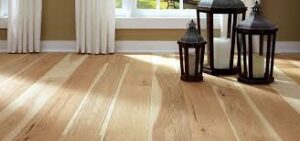
Reasons to Invest in Engineered Hardwood Flooring
Hardwood is a beautiful and classic addition that increases the real estate value of any home. At the same time, it’s expensive and not easy to maintain.
For those who love the look of hardwood but need something more affordable and simple to look after, engineered hardwood is a great choice. Here are nine strong reasons why engineered floors are a great option for your home and budget.
It’s Strong and Durable
While solid hardwood planks made of 100% wood tend to crack, warp or cup when exposed to extreme environmental factors, that’s not the case with engineered hardwood.
They’re still made of wood, but instead of a single plank, they consist of multiple layers of plywood that are glued together and capped with a solid wood top layer or lamella. This unique construction makes them extremely tough and capable of withstanding heavy traffic in either homes or businesses.
This also makes engineered hardwood a great flooring choice for places where solid wood isn’t an option, such as over concrete floors or radiant heating systems.
It’s Resistant to Changes in Temperature and Moisture
Compared to solid wood and laminate, engineered wood doesn’t contract or expand with heat and moisture changes. This makes it less susceptible to cracking, warping or buckling. The reason behind this stability is its unique construction – layers of plywood, joined together with solid wood.
It Comes in a Range of Colours and Finishes
Although available in a wide range of species, designs, and grades, solid wood flooring is often very expensive. Engineered flooring comes in an even greater range of colours, grades and finishes, but at more affordable pricing.
So, whether you want a tough, glossy low-budget option or antique-looking high-quality flooring, you’ll find one that matches your needs.
It’s Easy to Install
Since solid hardwood planks are derived directly from a thick log of wood, their thickness usually ranges between ¾-inches and 7/16-inches. Engineered hardwood, on the other hand, is factory made by joining several high-density fiberboard layers and then topping them with a solid wooden board. They are wider than regular solid wood planks and cover greater areas of the floor; this means fewer joins and easier installation. While the staple or nail down method is popular with solid hardwood floors, you can staple, nail, float, or even glue engineered hardwood planks. The glue-down or click-lock varieties are especially popular with DIY flooring enthusiasts.
It Looks Like Hardwood
One of the most remarkable things about high-quality engineered floors is that they can mimic the look and feel of natural solid wood flooring.
The main difference between solid and engineered hardwood flooring lies in its construction and number of layers. These differences, however, are not evident once the installation is complete. Its high quality and professional installation means even the toughest critic won’t doubt the authenticity of engineered hardwood flooring.
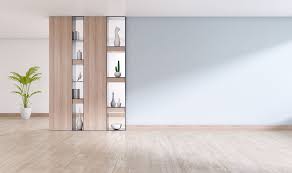
Other advantages of engineered wood floors
There are several advantages to be found when choosing engineered wood flooring over other flooring options. One of these is that it is often considered more universal by nature; since engineered wood floors are generally only about three-eighths to five-eighths of an inch thick, they can be fitted on top of existing floor surfaces, including often tricky concrete floors.
In addition, it is also considered more flexible and easier to install and maintain than many alternatives. This is largely due to being typically sold in easy-to-fit systems; you can choose between lengthier panels for installs which are ‘floating’ in style, or simply choose the straightforward tongue and groove pieces, which makes it more realistic to contemplate laying the flooring without the need of any professional assistance. Engineered wood also comes prefinished or finished in the pack – meaning no further preparation such as waxing or oiling of the wood needs to take place. This not only cuts down on extra costs for finishing products but also means that your flooring is ready to go, straight out of the box, saving you or your re-fitter costly additional labor time.
Is engineered wood flooring durable? The simple answer is yes, and the better you care for the floor, the longer it is likely to last. Maintenance of engineered wood flooring is simple to carry out and can be as easy as applying a quality laminate and wood cleaner ever so often. These specialist cleaners are neutral detergents that form a self-polishing film, highly resistant to wear and dirt that helps clean and protect the product. More intensive maintenance can also involve sanding down the surface or damaged parts of the wood. Bear in mind that there are only a limited number of times that manufacturers will recommend sanding down your engineered wood flooring. Typically, a professional sanding machine will remove anything from 0.25mm – 1mm off the top layer of the wood. For the varieties of engineered wood that feature thinner veneer layers, this must be done rarely and with caution.
How to hold down hardwood flooring costs
There are many choices available for the types of wood flooring you buy and the labor involved. Being aware of the differences within each category allows you to select less-expensive options that work for you.
- REFINISH INSTEAD OF REPLACE
You may be able to refinish a worn-looking hardwood floor. This least-expensive option works best if you know you’ll like the look of your current floor after it has been sanded and a fresh coat or two of finish has been applied. Solid hardwood can be refinished multiple times; engineered wood can be refinished fewer times.
- SHOP SPECIES
Most homeowners start shopping with appearance in mind: What color and shade would look best? Lovers of light-colored floors (think of most basketball courts) might prefer woods such as ash or maple. Fans of medium-shade floors might favor hickory or oak. Aficionados of dark-colored floors (think of the paneling in men’s clubs in old movies) might choose mahogany or walnut. Each species will have its own price range, with oak and hickory often at the lower end and mahogany at the higher end.
- CONSIDER GRAIN
The appearance of the wood’s grain, which comes from the way the wood is cut at the sawmill, affects price. Do you want the grain to run across the board, in wavelike patterns? That is a “plain-sawn” cut and is the least expensive.
Do you want the grain to run in lines down the length of the boards? Then you want a “quarter-sawn” or “rift-sawn” cut, which are more expensive than plain-sawn.
- CHOOSE THE GRADE
Wood floors are graded by their physical characteristics. Planks are graded “clear” if they have uniform color and lack knots and wormholes. A “select” grade goes to the natural look: wood with color variations, knots and mineral streaks. A “No. 1 common” grade has even more color variations and knots, and may even have wormholes. “No. 2 common” is a more rustic version of No. 1 common.
Generally speaking, wood graded clear is more expensive per square foot than select, and select is more expensive than common grades. You may find exceptions, especially during sales.




